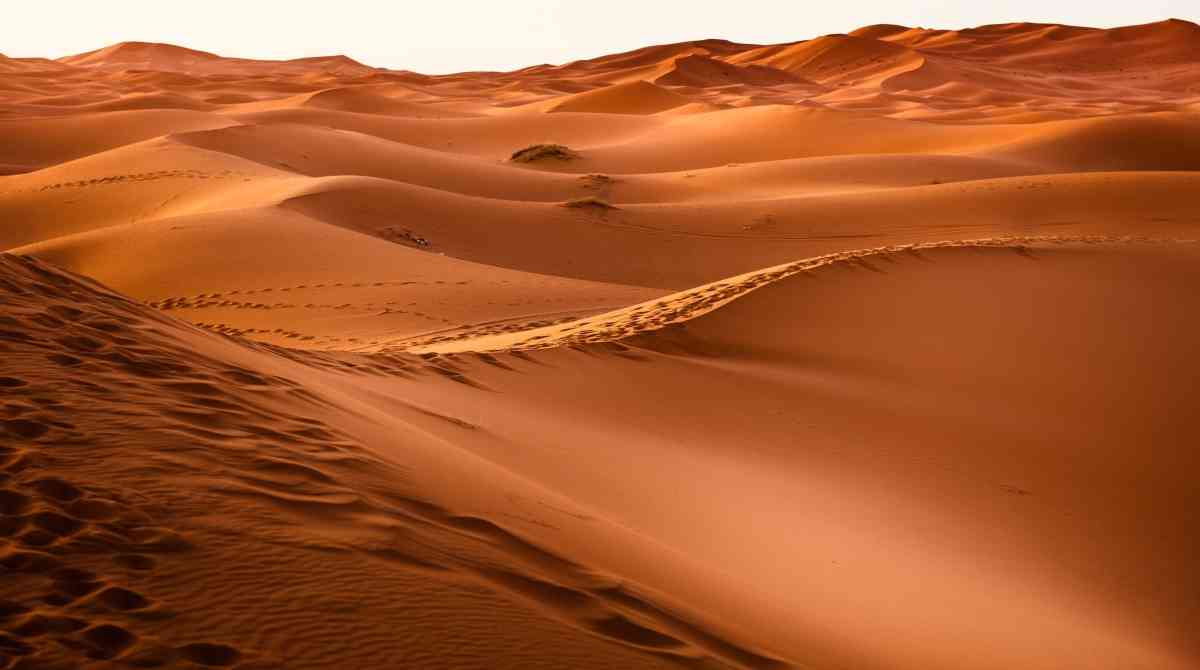
There are numerous types of deserts in the world. They are terrestrial biomes that receive the least amount of rain and the highest amount of solar radiation throughout the year. Most of them have very high temperatures, in some cases reaching 60 degrees at ground level during the hours of sunlight. However, not all deserts of the world have high temperatures. There are also those in which low temperatures predominate.
In this article we are going to tell you all the characteristics of the world's deserts.
Characteristics of a desert
The location of these types of biomes It is located between 15 and 35 degrees latitude in both hemispheres. In these regions we find an air circulation that produces low humidity in the environment. Most of the world's deserts are usually related to orographic rainfall. These precipitations are those that are found with a high altitude mountain. When an air mass rises up the mountainside, it cools and the humidity condenses, generating precipitation in the form of rain. The problem is that the rains are triggered on the mountain itself and it is delicate that the other part of the slope has low humidity conditions and gradually warms up.
If we take a look at the largest mountain ranges in the world, so that in the leeward part is where there are deserts due to the conditions we have mentioned. The most desert areas in the world are those where there are high atmospheric pressures that remain almost constant throughout the year. We are going to see which are the main deserts of the world and warm areas. The Sahara Desert, Australian Desert and the Atacama Desert are some of the most important.
Types and ecosystems of the world's deserts

But on that planet there are different types of deserts depending on their characteristics. Let's see what each of them are:
- Mid-latitude continental deserts: They are those who are on the opposite side of the mountain range complaint Lee suffer from drought conditions and high temperatures due to the fact that the precipitations discharge in the mountain area.
- North America desert: these deserts are characterized by high temperatures and very high aridity.
- Coastal deserts: are those that are located near the coast.
- Australian desert: This entire area stands out for having a very high air level.
- Cold subpolar and mountain deserts: these deserts stand out for having low temperatures and a much lower level of biodiversity due to extreme environmental conditions.
- Tropical and subtropical deserts: they have a smaller extension because the tropical climate tends to be prone to creating favorable environments for the development of biodiversity.
Desert ecosystems are those in which high levels of aridity predominate, triggering extreme environmental conditions. Some deserts, such as the Sahara desert, receive practically no rainfall throughout the year. This makes the forms of life found in these places almost nil. In other cases, we have deserts that do receive rainfall, but they are very sporadic. Normally, these precipitations are usually accompanied by storms.
Deserts that have a bit more rainfall tend to have a somewhat higher level of biodiversity. The specimens that can be found are drought resistant shrubs, cacti and other plants belonging to the group of succulents. The cactus is presented in a folded shape and allows it to expand when it absorbs water during periods of rain. In addition, when there are rains, annual plants bloom in a more vigorous way.
As for the animals, reptiles and insects have shown remarkable adaptation to arid environments. Most of them have nocturnal habits to avoid the high temperatures of the day. There are also some that are active during the cooler months. There are some ecosystems that are found at high altitudes and at latitudes that cause them to be exposed to low temperatures during winter. Here we have the desert of Nevada and Utah that are usually reached by snow.
Conditions in the world's deserts

We are going to see what are the reasons why there is a great temperature range and a lack of rainfall in these places. Arid environments are usually located in high pressure areas that act as a meteorological boundary between tropical and temperate latitudes. In these areas the movement of air prevails on the surface towards the opposite side of the high pressure areas. This air is supported by other air that descends through higher levels as part of the overall circulation of the Hadley cell.
The air that blows in the world's deserts is characterized by being hot and dry. At ground level there are temperature inversions that lead to the central areas of high pressure to be characterized by an absence of men and little precipitation. On the other hand, we have the hand of man that causes certain areas where there are intensive crops or for forests to produce a negative effect that causes desertification. Desertification is one of the environmental impacts that is causing the loss of fertile soil worldwide and a considerable reduction in biodiversity.
Another reason why these adverse conditions exist in the desert climate. By having areas of low pressure at ground level that are generated by high daytime temperatures and clear skies, there are areas where the thermometers rise to values of 40 degrees and higher.
Soils
The soils of the world's deserts show very little wear and tear and do not contain any humus. It has a sandy texture and in some of them it is noticeable in plant growth. This growth provides an accumulation of plant debris on the surface of the soil and the source of food for fauna. The lack of water filtration and chemical weathering make them not very fertile.
I hope that with this information you can learn more about the world's deserts and their characteristics.
